Key takeaways:
- Environmental storytelling enhances player engagement by allowing game environments to convey emotions and narratives without dialogue.
- Key elements include symbolism, detail, and lighting, which together create immersive experiences that evoke strong emotional connections.
- Effective techniques involve strategic placement of environmental cues, layering backstory within the environment, and managing pacing for emotional impact.
- In programming tutorials, storytelling enhances learning by connecting technical concepts to relatable real-world experiences, fostering deeper engagement and understanding.
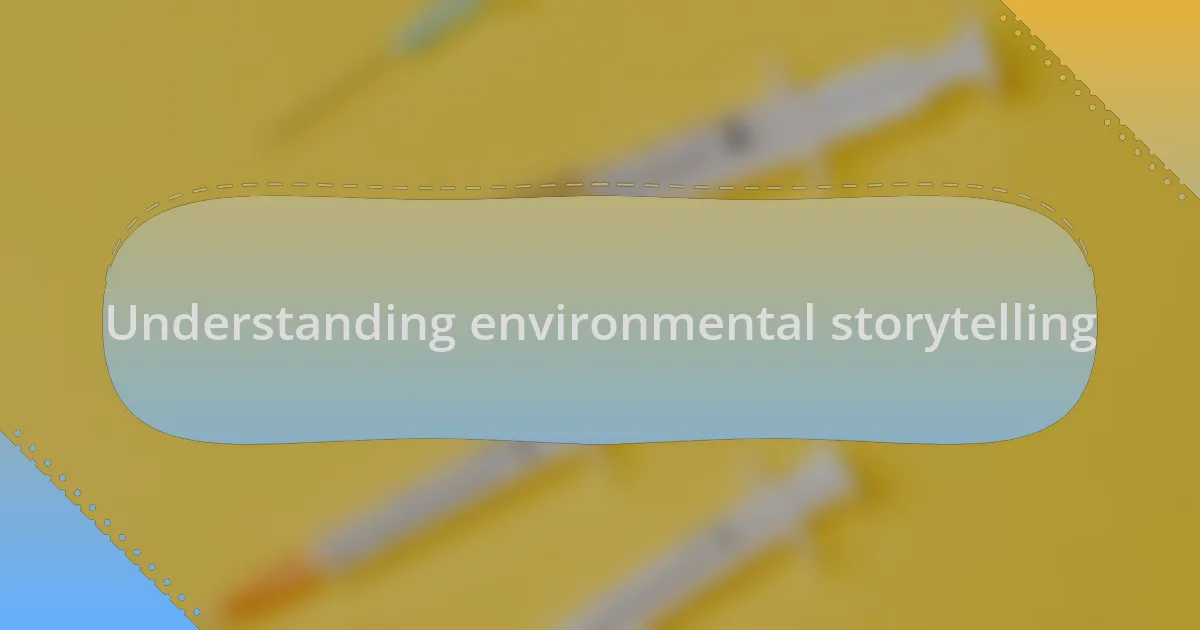
Understanding environmental storytelling
Environmental storytelling is a powerful tool in game design, weaving narratives through the game world itself. I remember the first time I encountered this concept while playing a visually stunning indie game; the artifacts and scenery told a tale far deeper than the dialogue ever could. It made me wonder—how can spaces reveal layers of a story that words alone often fail to capture?
It’s fascinating to consider how the placement of objects and the design of landscapes can evoke emotions. For example, a dilapidated building surrounded by overgrown flora instantly conveys abandonment and mystery. Have you ever found yourself feeling a connection to the environment without any explicit narrative? That’s the essence of environmental storytelling—creating a mood and guiding the player’s experience through thoughtful design.
When I reflect on my experiences, there’s a certain magic in discovering hidden details like graffiti or remnants of past lives in a game. Each element sparks curiosity and deepens my immersion. You start to piece together the larger story, often leaving a much stronger impression than scripted lines can. It’s a reminder that every pixel and polygon has the potential to tell its own story.
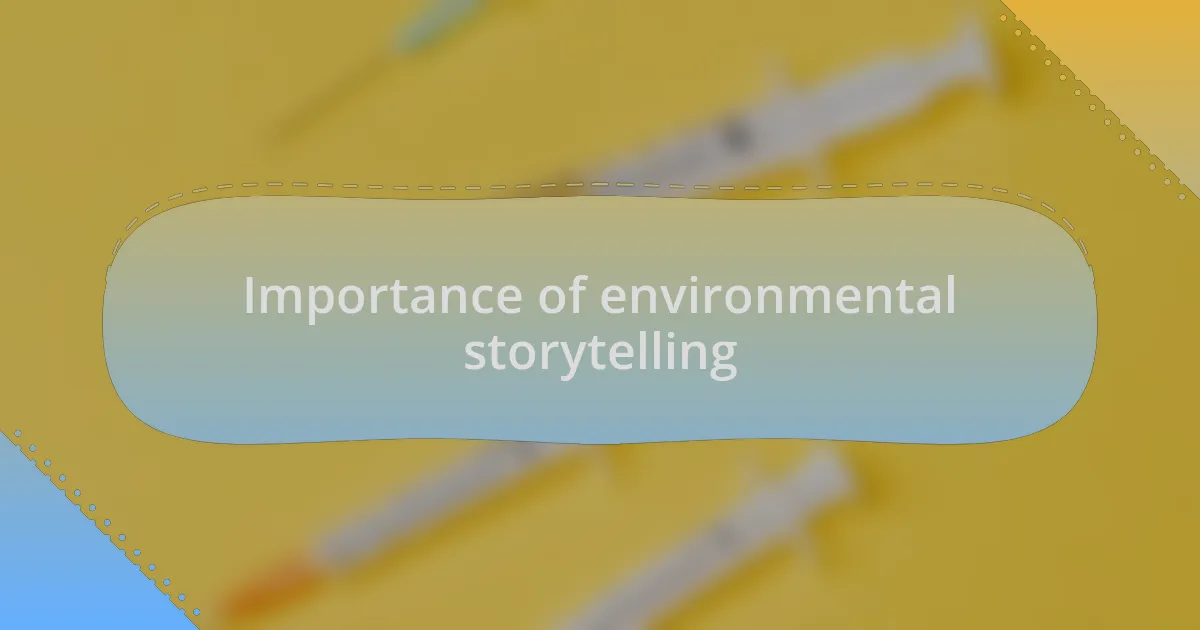
Importance of environmental storytelling
Environmental storytelling serves as an unspoken dialogue between the player and the game world. I recall walking through a misty forest in a game where the foliage felt alive, whispering secrets as I approached. This immersive experience made me reflect on how such environments can communicate backstories and emotions without needing a single line of dialogue.
The significance of environmental storytelling goes beyond just evoking feelings; it enhances player engagement and connection. I remember feeling a chill when I discovered a blood-stained artifact hidden deep in a dungeon. It sparked my imagination and made me question what had occurred there, demonstrating how the surroundings can create an impactful personal connection that scripted narratives sometimes fail to achieve.
In my opinion, environmental storytelling transforms ordinary gameplay into a rich, sensory experience. Have you ever found yourself lost in a game because the environment felt so inviting? I think that’s the ultimate goal of designers—to create spaces that not only impress visually but also resonate emotionally, fostering a bond that lingers with players long after the game has ended.
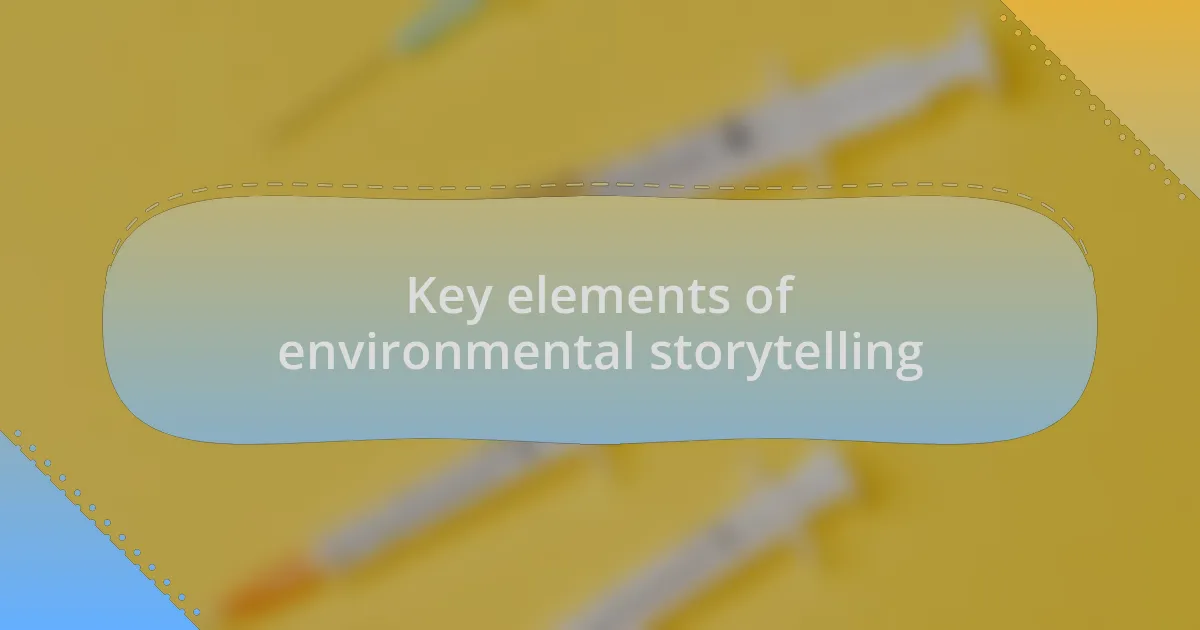
Key elements of environmental storytelling
Key elements of environmental storytelling revolve around the details that breathe life into the game world. I once played a survival horror game where the crumbling walls and scattered belongings told the story of a once-thriving community now fallen to despair. What struck me most was how these minute details could evoke a sense of loss and tragedy without uttering a single word.
Another key element is the use of symbolism within the environment. I remember stumbling upon a withered tree in a fantasy game, and its presence spoke volumes about the struggle between life and decay. It made me ponder—how can a mere tree represent the overarching themes of hope and despair in a narrative? Such symbols contribute layers of meaning that enrich the storytelling experience.
Additionally, the interplay of light and shadow can evoke strong emotions, setting the tone for the players’ journey. I vividly recall walking through a dimly lit corridor, where the flickering lights created a sense of foreboding. This use of lighting prompted me to question my surroundings—was I safe, or were hidden dangers lurking just out of sight? This manipulation of ambiance draws players deeper into the story, making every corner of the environment a potential reveal.
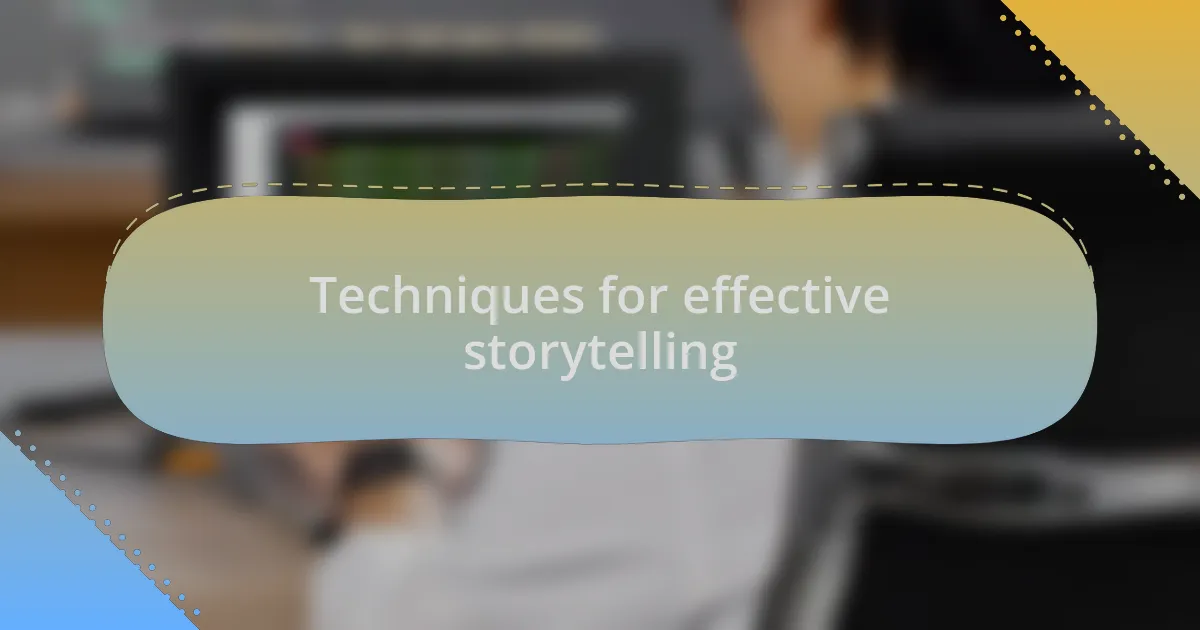
Techniques for effective storytelling
When I craft a narrative, one technique that I find particularly effective is the strategic placement of environmental cues. For instance, I once played a game where I entered a bright, sunlit area after navigating through a dark cave. That contrast not only felt refreshing but also symbolized hope after adversity, prompting me to reflect on my journey. This kind of purposeful design can send powerful messages without relying on spoken dialogue.
Another approach I often employ is layering backstory within the environment itself. I remember exploring a forgotten village, where each dilapidated building bore traces of its former life—faded paintings on walls and remnants of personal items. These details ignited a curiosity in me about the lives that had touched these places, encouraging me to piece together the narrative. Have you ever found yourself drawn to a setting because of the stories it seems to tell? This technique invites players to become active participants in storytelling.
Lastly, I’ve noticed the significance of pacing in environmental storytelling. There have been moments when a sudden, tense silence enveloped the space, amplifying the anticipation of what lay ahead. Such careful control of rhythm can enhance emotional engagement. Just think about it—how does silence affect your perception of danger in a game? By manipulating auditory elements, I believe storytellers can drastically shape the player’s experience, leading to a more immersive narrative.
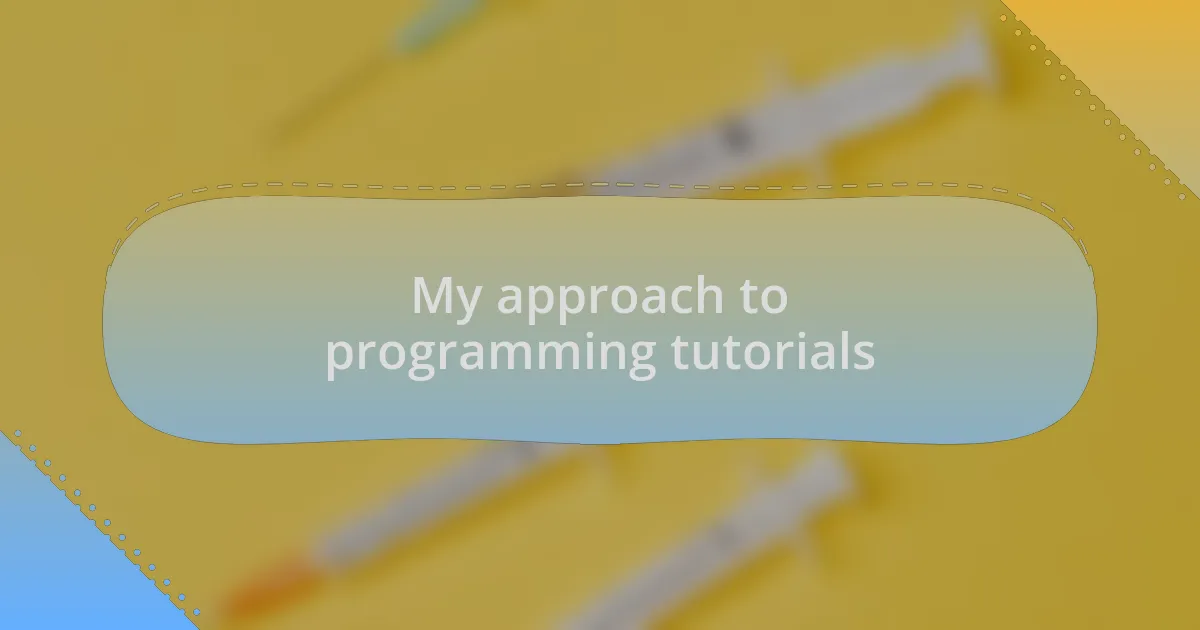
My approach to programming tutorials
When I design programming tutorials, I prioritize clarity above all else. I remember a time when I struggled with a particularly complex coding concept because the tutorial I followed was filled with jargon. That experience taught me the importance of breaking down difficult ideas into simple, relatable terms. It’s vital to create an environment where learners feel comfortable asking questions, so I always include examples that resonate with everyday situations.
I also like to weave in real-world applications to make the tutorials more meaningful. For example, when discussing algorithms, I often relate them to everyday decision-making processes, like choosing what to wear based on the weather. This approach not only keeps my readers engaged but also helps them connect the dots between programming concepts and their practical implications. Have you ever considered how much logic goes into daily choices? That recognition can spark a deeper understanding of programming principles.
Moreover, I strive to create an engaging narrative throughout my tutorials. I once received feedback from a learner who said they felt as if they were part of a journey rather than just following instructions. It reinforced my belief in storytelling’s power to enhance the learning experience. When your tutorials tell a story, it transforms the process from tedious to inspiring—what could be better than that?
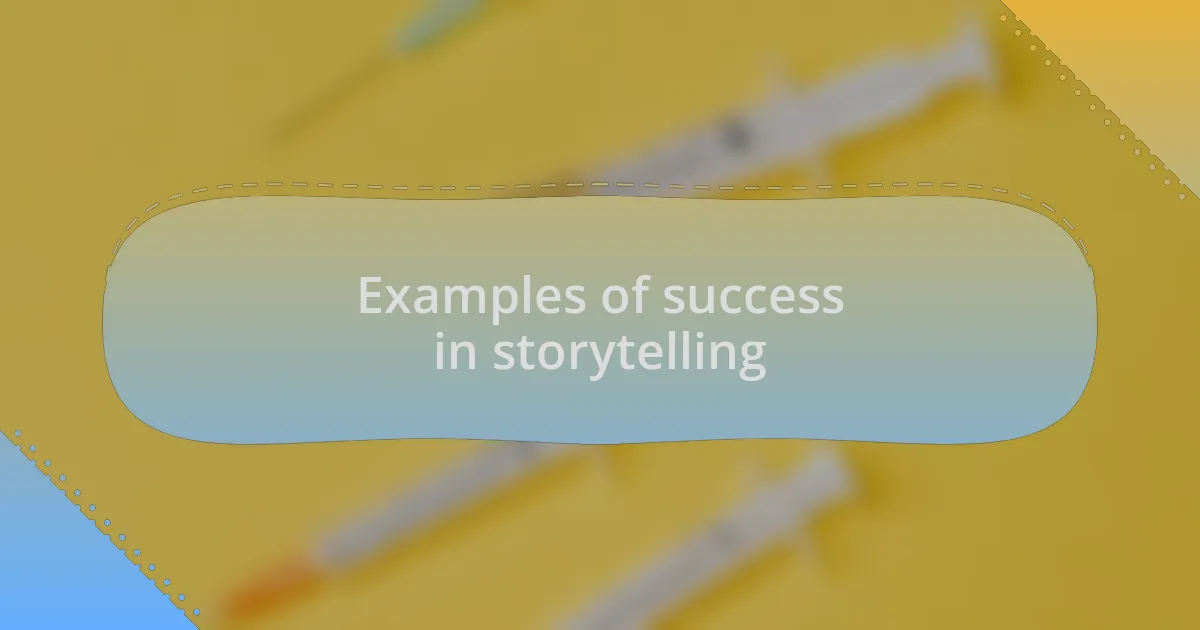
Examples of success in storytelling
Successful storytelling can transform a standard programming tutorial into something memorable. For instance, I once shared a project about building a simple game and how it mirrored my childhood experiences of creating makeshift games with friends. Many readers connected with that nostalgia, making the learning process not just about code but also about the joys of creativity and collaboration.
Another example comes from a tutorial focused on web development. I narrated my first experience launching a website and the sense of accomplishment I felt when it went live. It was like watching a seed I planted grow into a tree. This emotional connection not only made the technical details more relatable but also encouraged readers to envision their success, inspiring them to push through challenges.
I think about how often storytelling is overlooked in tutorials. Why is that? I believe it’s because people sometimes underestimate its impact on understanding complex topics. By integrating stories from my journey, I’ve seen learners engage at a deeper level, igniting their passion for coding and fostering a sense of community among users. It’s a reminder that in the world of programming, there’s always more to the code than meets the eye.